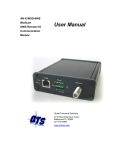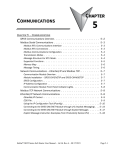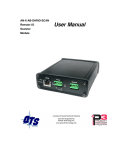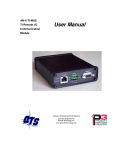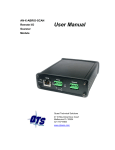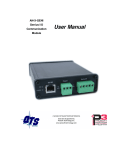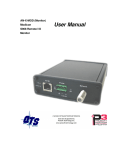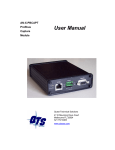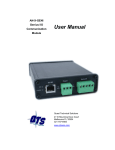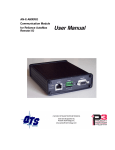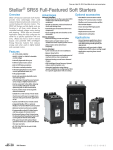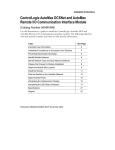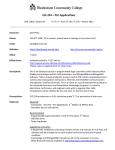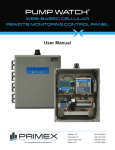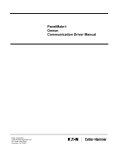Download AN-X-DCSNet2 Communication Module User Manual
Transcript
AN-X-DCSNet2 Communication Module User Manual Page 2 AN-X-DCSNet2 November 2011 Because of the variety of uses for the products described in this publication, those responsible for the application and use of these products must satisfy themselves that all necessary steps have been taken to assure that each application and use meets all performance and safety requirements, including any applicable laws, regulations, codes and standards. In no event will Quest Technical Solutions be responsible or liable for indirect or consequential damage resulting from the use or application of these products. Any illustrations, charts, sample programs, and layout examples shown in this publication are intended solely for purposes of example. Since there are many variables and requirements associated with any particular installation, Quest Technical Solutions does not assume responsibility or liability (to include intellectual property liability) for actual use based upon the examples shown in this publication. Throughout this manual we use notes to make you aware of safety considerations. Identifies information about practices or circumstances that can lead to personal injury or death, property damage, or economic loss. These warnings help to: WARNING! IMPORTANT! TIP • identify a hazard • avoid the hazard • recognize the consequences Identifies information that is especially important for successful application and understanding of the product. Identifies information that explains the best way to use the AN-X-DCSNet2 Microsoft is a registered trademark of Microsoft Corporation. Windows, Windows XP Windows Vista and Windows 7 are trademarks of Microsoft Corporation. ControlLogix, RSLinx and RSLogix 5000 are trademarks of the Allen-Bradley Company, Inc. AN-X-DCSNET2 MODULE OVERVIEW 2 Hardware Features 3 Package Contents 3 Other Requirements 3 Modes of Operation 4 INSTALLATION 5 Prevent Electrostatic Discharge 5 Power 5 DCSNet Cabling and Termination 5 Ethernet Cabling 6 Software Installation 6 ETHERNET CONFIGURATION 7 Ethernet Configuration Example: Standalone Computer 7 12 Reconfiguring an AN-X from an Unknown State 16 DCSNET CONFIGURATION 17 USING THE AUTOMAX PROGRAMMING SOFTWARE 18 Requirements 18 Installing and Configuring the VDD 18 Configuring the Programming Software 19 Multiple Programmer Access 20 Connecting to a Different AN-X 21 SCHEDULED DATA WITH A CONTROLLOGIX 22 Requirements 23 Page 4 AN-X-DCSNet2 November 2011 Reference 23 Configuring AN-X in RSLogix 5000 Exclusive Owner Connection Input Only Connection 23 23 27 Mapping the DCS Data ControlLogix Name ControlLogix Prefix I/O Data Sample File – DCS Slave Sample File – DCS Master 29 29 29 30 32 33 Sending the Configuration to AN-X 33 Viewing the Current Configuration 34 Error Log 34 Exporting Aliases from AN-X 34 Using RSLogix 5000 to Diagnose Problems General Tab Connection Tab 35 35 35 USING ANXINIT 36 AnxInit Log 36 Locating Available AN-X Modules 37 Selecting an AN-X 38 Set AN-X IP Configuration 38 Restart an AN-X 39 AN-X Info 40 Read Kernel Parameters 40 Run Config Mode 41 Update AN-X Flash 41 Update Firmware Firmware Update Wizard Update Firmware Command 42 42 46 Patch Firmware 46 USING THE WEB INTERFACE 48 DCSNet Configuration 48 Configure ControlLogix Support 50 View Configuration Files 50 View Active Configuration 51 Monitor DCS Data 53 Log Files System Error Log System Info Log ControlLogix Log View All Logs 54 54 54 54 54 Administration Menu Browse File System AN-X IP Configuration Archive Configuration Restart AN-X Module 54 54 55 56 57 TROUBLESHOOTING 58 LEDs Ethernet LEDs SYS LED NET LED – DCS Network Status 58 58 58 59 DCS Diagnostic Counters 59 UPDATING THE FIRMWARE 61 Reading Version Numbers 61 SPECIFICATIONS 62 SUPPORT 63 WARRANTY 64 AN-X-DCSNet2 Module Overview The AN-X-DCSNet2 firmware runs on an AN-X AutoMax communications module and connects a computer or other device to a Reliance DCS network, using Ethernet. The module can act as a DCS master or a DCS slave. As a DCS master, the module: • Scans up to 55 slave drops • Transmits 8 words of broadcast data every 2.8 ms. • Maintains standard DCS diagnostic counters As a DCS slave, the module: • Acts as any drop from 1 to 55, with drop depth from 1 to 55. It supports 32 words of input data and 32 words of output data per drop • Receives 8 words of broadcast data from the master every 2.8 ms. • Monitors the input and output data on others drops on the network • Maintains standard DCS diagnostic counters You can use the AN-X-DCSNet module to communicate with an AutoMax processor, using AutoMax Programming Executive 3.9A or 4.3A or above. Refer to page 18 for details. Note that AutoMax programming software access is not supported under Windows Vista. The AN-X-DCSNet2 firmware differs from the standard AN-X-DCSNet firmware in that it supports up to 15 scheduled data connections to a ControlLogix processor, whereas the standard firmware supports just one scheduled connection. Use the AN-X-DCSNet2 firmware in applications where you have a large DCS network and want the data to update quickly. The AN-X-DCSNet2 firmware does NOT support direct AN-X to AN-X communication over Ethernet. If you need this function, use the standard AN-X-DCSNet firmware. The AN-X-DCSNet module supports exchanging scheduled data over Ethernet with a ControlLogix processor, with RPIs from 5 to 750 ms. Refer to page 22 for details. The AN-X-DCSNet module has a web interface for configuration of DCSNet operation and for monitoring operation and data. You can communicate with the module using any standard web browser such as Internet Explorer. The module firmware can be updated over Ethernet using the Windows utility supplied. Refer to page 61 for details. AN-X-DCSNet2 Page 3 Hardware Features The module has: • LEDs to indicate the status of the connection to the Ethernet, its own internal state, and the connection to the DCS network • an Ethernet connector • a 9-pin D-shell connector to connect to the DCS network • a power connector A watchdog timer is implemented in the module’s hardware. If the firmware does not kick the watchdog within the timeout period the watchdog times out and places the module into a safe fatal failure state. A jabber inhibit timer is implemented in the module’s hardware. If the network transmitter is on longer than 150% of the longest network frame time, the transmitter is forced off and the module is placed into a safe fatal failure state. Package Contents • AN-X-DCSNet module • CD containing software and documentation Other Requirements To use the AN-X-DCSNet with the AutoMax Programming Executive requires: • version 3.9A or 4.3A or above of the programming executive • version 3.1.0.4 or above of the Virtual Device Driver Page 4 AN-X-DCSNet2 November 2011 To exchange scheduled data with a ControlLogix processor over Ethernet requires: • version 12 or above of RSLogix 5000 • version 12 or above of the ControlLogix firmware • 100 Mbit/second Ethernet network and hardware (ENBT) Modes of Operation There are three AN-X modes of operation: • Boot mode. The AN-X is running its low level startup firmware. • Configuration mode. This is the mode when you are updating the firmware in the AN-X. • Production mode. This is the normal runtime mode of operation. AN-X-DCSNet2 Page 5 Installation Prevent Electrostatic Discharge The module is sensitive to electrostatic discharge. Electrostatic discharge can damage integrated circuits or semiconductors. Follow these guidelines when you handle the module: WARNING! • Touch a grounded object to discharge static potential • Do not touch the connector pins Power AN-X requires a DC power input of anywhere from 12 to 24 VDC. Left to right the pins on the power connector are chassis ground, negative voltage and positive voltage. The chassis ground should be connected. Power consumption internally is 300 mA @ 12VDC or 150 mA @ 24VDC. The part number for the power connector is Phoenix MSTB 2.5/3-ST-5.08 Contact us if you need a suitable wall adapter. DCSNet Cabling and Termination Use a DCSNet drop cable (612574-36R or 612403-036R) and passive tap (M/N 57C380) to connect the module to the coaxial network cable. The drop cable is a 3-foot long multiconductor cable with 9-pin D-shell connectors at each end. Connect one end to the connector on the module and the other end to the passive tap. Page 6 AN-X-DCSNet2 November 2011 The passive tap has two BNC connectors for connection to the coaxial cables and terminating loads. The network coaxial cable must be terminated with 75 ohm terminating loads attached to the taps at the physical ends of the network. There should be two and only two terminators on the network. The DCS network cable can be RG-59/U or RG-11/U. Ethernet Cabling AN-X has a standard RJ-45 connector for connecting to Ethernet. If you are connecting AN-X to an existing network through a router or switch, use a standard Ethernet cable. If you are connecting a computer or PLC directly to an AN-X, use a crossover cable. Software Installation You must uninstall any previous version of the software before you can install a new version. Use the Windows Control Panel Add and Remove Programs to remove the old version. Insert the CD supplied with the AN-X module and run the program setup.exe on the CD. AN-X-DCSNet2 Page 7 Ethernet Configuration The AN-X-DCSNet2 module connects a computer or other device on Ethernet to a Reliance DCS network. Before you can use the AN-X-DCSNet2, you must configure its Ethernet network properties. Ethernet Configuration AN-X can be configured to use a static (unchanging) IP address or it can be configured to obtain its IP address from a DHCP server. Unless you have control of the DHCP server, in most applications you will configure AN-X to use a static IP address. Otherwise the DHCP server may assign a different IP address each time AN-X powers up, and any software that accesses the AN-X module would have to be reconfigured. AN-X is shipped with DHCP enabled. If it finds a DHCP server on the network, the DHCP server assigns it an IP address. You can use the utility AnxInit to find the IP address that the DHCP server has assigned. Select Utilities/Locate All AN-X Modules and AnxInit will locate the AN-X and display its IP address. If AN-X does not find a DHCP server within about three minutes of starting up, it reverts to a temporary static IP address of 192.168.0.41 If Page 8 AN-X-DCSNet2 November 2011 AN-X is using this temporary IP address, it repeatedly flashes the SYS LED three times followed by a pause. IMPORTANT! Use this temporary IP address only for initial setup of AN-X. AN-X will not function for its intended purpose at the temporary IP address. If you are using multiple AN-X modules, configure one at a time, especially if there is no DHCP server on the network, since they will all revert to the same temporary IP address when they fail to find a DHCP server. IMPORTANT! If you are connecting AN-X to an existing Ethernet network, consult the network administrator to obtain a static IP address for AN-X and to obtain other information about how you should configure AN-X. IMPORTANT! The AN-X must be on the local Ethernet (same subnet as the computer) when you set its IP address. You configure the Ethernet properties using the Windows utility AnxInit supplied with AN-X. You can also set the IP address through the web interface. Refer to page 55 Use the Configuration/AN-X IP Settings command to start the AN-X IP configuration wizard, which takes you step by step through the IP configuration process. Step 1 In step 1, you identify the AN-X you are configuring. AN-X-DCSNet2 Page 9 1. Select the Ethernet adapter that’s connected to the AN-X. In most cases there will be just one Ethernet adapter in the computer. The AN-X must be on the same subnet as the computer. 2. Enter the MAC address of the AN-X you are configuring. This is printed on the AN-X label. It consists of six pairs of hexadecimal digits, separated by hyphens. In the example above, it’s 00-0c-1a-00-00-0a. If the AN-X is already online, you can obtain its MAC address using the Utilities/Locate All AN-X Modules command. 3. Enter the IP address you intend the AN-X to use. Step 2 In step 2, you choose a method of restarting AN-X to put it in boot mode. Page 10 AN-X-DCSNet2 November 2011 The preferred method is to cycle power on the AN-X. Select the first option on the screen, power off the AN-X, and click the Next >> button. The second method, useful if the AN-X in not easily accessible, is to send it a command over Ethernet. The AN-X must be powered on and completely running for this method to work. For example, if this is the first time you are configuring a new AN-X, allow sufficient time for it to acquire an IP address from a DHCP server or to time out and use its default IP address (about 3 minutes). Select the second option on the screen and click the Next >> button. Step 3: If you powered off the AN-X, turn it back on. Wait for AN-X to enter boot mode. While AnxInit is waiting, the Next>> button is disabled. When AN-X is in boot mode, the Next>> button is enabled. AN-X-DCSNet2 Page 11 If the AN-X does not enter boot mode within about 10 seconds, return to the previous screens and check the entries. The AN-X TCP/IP Configuration dialog appears. Page 12 AN-X-DCSNet2 November 2011 Enter a Host Name for the AN-X. This name is used internally by AN-X and may be used to identify the AN-X if you have a DNS server on your network. The name can be from 1 to 31 characters long. To configure the AN-X to obtain its IP address from a DHCP server on the network, select Obtain an IP address automatically (DHCP) To configure the AN-X to use a static IP address, select Use the following Settings and enter: • the desired IP address for the AN-X. • the Subnet mask for the AN-X • the default gateway for your network. You must enter a valid default gateway address even if there is no device at the gateway address on the network. Click OK to complete the configuration. If you Cancel the Configuration/AN-X IP Settings command, AN-X is left running the boot code. Use the Utilities/Restart AN-X command to restart the AN-X. You can also reconfigure the AN-X IP parameters from the web interface. Refer to page 55. Example: Standalone Computer A typical example is a laptop computer running the AutoMax programming software and connecting directly to an AN-X to program an AutoMax processor. Since you are connecting directly from the computer to AN-X, use a crossover Ethernet cable. The following instructions assume that an Ethernet network card has been installed in the computer and that AnxInit has been installed on the computer. TIP The parameters in this example will work when you set up any standalone computer to work with AN-X. First configure the computer to use a static IP address. From the Start menu, select Start/Settings/Network and Dialup Connections. Double click on Local Area Connection. AN-X-DCSNet2 Page 13 Click the Properties button. Double click on Internet Protocol (TCP/IP). Page 14 AN-X-DCSNet2 November 2011 In this example, we will assign the computer an IP address of 192.168.0.10 Set the Subnet mask to 255.255.255.0 (standard mask for the Class C network address of 192.168.0.x). Set the Default gateway to 192.168.0.1 (this address does not exist on the Ethernet network but AN-X requires a valid default gateway entry). Click OK to accept the settings Connect the computer to AN-X using the crossover cable. If this is the first time you have used the AN-X module, it will look for a DHCP server on the network. It waits about three minutes, then reverts to a default IP address of 192.168.0.41 Power up the AN-X and wait for the search for a DHCP server to time out. When the search for a DHCP server times out, AN-X will flash the SYS LED red three times followed by a pause repeatedly. Run AnxInit. Select Utilities/Locate All AN-X Modules and confirm that the AN-X is found. AN-X-DCSNet2 Page 15 Select Utilities/Select An AN-X and enter the MAC Address and IP address. Click OK to accept the setting. Select Utilities/AN-X IP Configuration. Enter an IP Address. In this case we chose 192.168.0.10 Enter the same Subnet mask and Default gateway that you entered for the computer. The default gateway address does not exist on the network but AN-X requires that the field have a valid entry. Click Finish to accept the settings. Select Utilities/Restart AN-X to restart AN-X with the new parameters. When the AN-X has restarted (SYS LED is solid green), select Utilities/Locate All AN-X Modules and confirm that the AN-X is found with the new parameters. Page 16 AN-X-DCSNet2 November 2011 Reconfiguring an AN-X from an Unknown State It sometimes happens that an AN-X has been previously configured with an IP address that causes it to be inaccessible on the current Ethernet network. To reconfigure it to a known state, run the command Configuration/AN-X IP Settings to start the AN-X IP Configuration Wizard and reconfigure the AN-X. AN-X-DCSNet2 Page 17 DCSNet Configuration You set the DCS mode of operation (master or slave) and the drop number and depth using the web interface. Start your web browser and enter the AN-X IP address as the address. Select Automation Network/DCSNet Configuration to set the DCS drop number and depth. AN-X-DCSNet can be used as a DCS master or slave. Check Master or Slave to select which one you want. If the AN-X-DCSNet is a DCS slave, enter the Drop Number and Drop Depth. These entries are ignored if the AN-X is a DCS master. Click the SUBMIT button to send the values to AN-X. AN-X defaults to DCS slave operation with drop number 55 and drop depth 1. For further details, refer to page 48. Page 18 AN-X-DCSNet2 November 2011 Using the AutoMax Programming Software Any computer with Ethernet access can use an AN-X-DCSNet module to connect to an AutoMax processor over DCSNet. IMPORTANT! The Virtual Device Driver runs under Windows XP or Windows 7 but does not run under Windows Vista. The following instructions assume that: • AN-X has been configured and is active on the Ethernet network • AN-X has been connected to the DCS network • the AN-X DCS drop number and drop depth have been assigned (see page 48) To use AN-X-DCSNet with the AutoMax Programming Executive, you must complete the following steps: 1. Install and configure the Virtual Device Driver (VDD) 2. Configure the programming software to use AN-X Requirements • Virtual Device Driver (VDD) version 3.1.0.4 or above, available on the AN-X distribution CD • AutoMax Programming Executive 3.9 or 4.3 or above Installing and Configuring the VDD 1. Install the virtual device driver. Insert the AN-X distribution CD that contains the Virtual Device Driver and install it. 2. Run the Control Panel Applet (Start/Control Panel/QTS PC Link Card Configuration and set the Port Address and Memory Address. You can leave them at their default values. 3. Check Enable AN-X-DCSNet Link 4. Enter the IP address of the AN-X in the AN-X IP Address field. If you do not know the IP address, use Utilities/Locate All AN-X Modules in AnxInit (see page 37) to find it. 5. Click OK. AN-X-DCSNet2 Page 19 Configuring the Programming Software To configure the AutoMax Programming Executive to use AN-X: 1. Run the Programming Executive 2. Select Setup/Communications. The Communications Setup dialog appears. Page 20 AN-X-DCSNet2 November 2011 3. Set the Communications Type to PC Link Interface Module. 4. Set the Drop to match the AN-X drop number on DCS 5. Set the Segment to match the Memory Address in the VDD Configuration. 6. Set the Port Addr to match the Port Address in the VDD configuration. 7. Click OK to complete the configuration. You should now be able to go online with the AutoMax Programming Executive. Multiple Programmer Access The AutoMax operating system uses the source of programming messages (direct connection to the serial port or drop number on DCSNet) to distinguish between programmers. It uses the identity of each programmer to manage levels of access (None, Data, Task) and to return requests for data to the programming devices. The AutoMax operating system controls the operations that programming device can perform, depending on their access level. AN-X-DCSNet2 Page 21 If multiple copies of the Programming Executive attempt to program an AutoMax through the same AN-X-DCSNet, the AutoMax sees them as a single user since they are all connected using the drop number of the AN-X-DCSNet. This causes the following anomalous behavior in the programming devices: • variables, I/O and ladder logic may be displayed incorrectly since the same data is sent to all devices connected to the same AN-XDCSNet • each Programming Executive connected through the same AN-XDCSNet receives the same access level. If you change the access level on one, the AutoMax operating system changes to the same level on all of them. This defeats the built-in access management in the AutoMax. Each copy of the Programming Executive should communicate with the AutoMax using a different AN-X-DCSNet to ensure that the AutoMax operating system can properly detect them as separate copies of the Programming Executive. Multiple copies of the Programming Executive should NOT be connected through the same AN-X-DCSNet. Each programmer should use a separate AN-X. Connecting to a Different AN-X If you have more than one AN-X on the Ethernet network, each connected to a different DCS network, to change the AN-X your programming software is using, run the Control Panel Applet (Start/Control Panel/QTS PC Link Card Configuration and change the IP address in the AN-X IP Address field. If you do not know the IP address, use Utilities/Locate All AN-X Modules in AnxInit (see page 37) to find it. Page 22 AN-X-DCSNet2 November 2011 Scheduled Data with a ControlLogix AN-X-DCSNet2 exchanges scheduled data with a ControlLogix processor. It supports: • up to 16 scheduled connections • up to 248 registers of ControlLogix output data per connection • up to 250 registers of ControlLogix input data per connection The ControlLogix processor sends its output data to the AN-X-DCSNet2 and the AN-X sends it out on the DCS network. You create a configuration file to define how the ControlLogix data is mapped to DCSNet registers. If the AN-X is a DCS master, allowed output data includes registers 32 to 39 on drop 0 (broadcast data) and registers 32 to 63 on drops 1 to 55. If the AN-X is a DCS slave, allowed output data includes registers 0 to 31 on any drops (1 to 55) that are included in the AN-X drop number and drop depth. The AN-X sends input data to the ControlLogix. The configuration file defines how DCSnet data is mapped to ControlLogix input data. There are no restrictions on which DCS registers can be mapped to ControlLogix input data. In addition, you can also map connection statistics to ControlLogix inputs. You define data mappings in a comma-separated text file and use the AN-X web interface to send the mapping file to the AN-X. Connections There are two possible types of scheduled connections from the ControlLogix processor to the AN-X-DCSNet: • Exclusive owner connection, which contains input and output data • Input-only connection, which contains input data Only the exclusive owner connection can write data to AN-X and to DCSNet. There can be only one exclusive owner connection to an AN-X module. In general, you should try to keep the number of connections small. There is significant overhead in opening and maintaining each connection. Configuration To configure the scheduled data exchange: 1. Configure AN-X in RSLogix 5000 AN-X-DCSNet2 Page 23 2. Map DCS data to the scheduled data and save the mappings as a comma separated variable (CSV) file 3. Send the configuration file to AN-X Requirements • RSLogix 5000 version 12 or above • ControlLogix processor with firmware version 12 or above • 100 Mbit Ethernet network and ENBT modules. We strongly recommend using Ethernet switches rather than hubs Reference Allen-Bradley publication EtherNet/IP Media Planning and Installation Manual, publication ENET-IN001A-EN-P Configuring AN-X in RSLogix 5000 The AN-X-DCSnet2 emulates a 17-slot 1756 chassis with an ENBT/A in slot 16 and generic modules in slots 0 to 15. Exclusive Owner Connection To configure the AN-X-DCSnet2 in RSLogix 5000: 1. Right click on the ControlLogix Ethernet bridge module that will be communicating with the AN-X and select Add Module. Add a 1756-ENBT/A module. Set the Major Rev to 1. Page 24 AN-X-DCSNet2 November 2011 Enter the Name. Use the host name you assigned to AN-X when you configured its IP properties. Set the Slot to 16 and the chassis size to 17. Set the Comm Format to None. Set the IP address to match the AN-X module. Set Electronic Keying to Disable Keying. Click OK to accept the settings 2. Add Generic modules for each scheduled connection. Right click on the backplane and select New Module. From the Other category, select 1756-MODULE. AN-X-DCSNet2 Page 25 Set the Name and Description as desired. Set the Comm Format to Data – INT. Set the other parameters as shown. Set the Slot to 0 for connection 0, 1 for connection 1, and so on. 3. Set the RPI for each connection. IMPORTANT! Ensure that any check box that refers to Unicast connections is unchecked. Page 26 AN-X-DCSNet2 November 2011 AN-X supports RPIs from 5 to 750 ms. Select an RPI appropriate to the DCS network scan time and to your application. The approximate DCS network update time is 3 ms per drop. The DCS network update time is given by: Update time = (DropTime * N) + NewDropTestTime + MessageTime where DropTime = the amount of time for a master to send a message and the slave to respond = 2.99 ms N = Number of slave drops (physical and virtual) NewDropTestTime = amount of time for the master to poll an inactive drop and wait for its response = 2.48 ms assuming no response MessageTime = amount of time to transfer programming terminal messages. If the master is sending a message, this is 2.09 ms. If a slave is sending a message, this is 3.395 ms. Example: A network composed of 10 drops, with no messaging, updates each drop with a period of: UpdateTime = 2.99 * 10 + 2.48 = 32.38 ms AN-X-DCSNet2 Page 27 Input Only Connection The AN-X-DCSNET2 supports one input only connection from a ControlLogix processor. The ControlLogix processor will be able to read the same input data as the ControlLogix processor with the exclusive owner connection to the AN-X-DCSNET2. The data received will depend on the mappings in the AN-X-DCSNET2. To configure the input only connection to the AN-X-DCSNET2 in RSLogix 5000: 1. Right click on the ControlLogix Ethernet module that will be communicating with the AN-X and select Add Module. Add a 1756-ENBT/A module. Set the Major Rev to 1. Set the Slot to 16. Set the chassis size to 17. Set the Comm Format to None. Set the IP address to match the AN-X module. Set Electronic Keying to Disable Keying. 2. Add Generic modules for each required connection Page 28 AN-X-DCSNet2 November 2011 Set the parameters as shown. Set the Comm Format to Input Data – INT. Set the Slot to 0 for the first connection, 1 for the second connection, and so on. 3. Set the RPI for each connection to match the RPI of the exclusive owner connection. IMPORTANT! Ensure that any check box that refers to Unicast connections is unchecked. AN-X-DCSNet2 Page 29 Mapping the DCS Data You define the DCS data that is exchanged between the AN-X and the ControlLogix processor in a comma-delimited text file, which can be created using a spreadsheet such as Excel or using a text editor. ControlLogix Name The first line in the file contains the module name, used to create aliases that can be imported into RSLogix 5000. It consists of the keyword ClxName, a comma, and the name you gave the module when you configured in in RSLogix 5000. Example: ClxName, ANX The ControlLogix name is used in the address part of the alias. It can be up to 40 characters long. ControlLogix Prefix The second line in the file is the ControlLogix prefix, used to create the name part of the alias. The first field contains the keyword ClxPrefix. The second field contains text that prefixes the alias names created for the mapped data. The prefix can be up to 33 characters long. Page 30 AN-X-DCSNet2 November 2011 The ClxPrefix can be used to distinguish between AN-X modules when a ControlLogix processor communicates with more than one AN-X. Use a different prefix for each AN-X Example: ClxPrefix, ANX2 I/O Data Each scheduled connection to the AN-X begins with a line that consists of the keyword ClxSlot followed by a comma and then a number from 0 to 15 Example: ClxSlot, 0 This is followed by mappings of input and output data for that connection. Scheduled outputs from the ControlLogix processor for the connection begin with a line with just the keyword DataOutput. Scheduled inputs to the ControlLogix processor for the connection begin with a line with just the keyword DataInput. Data definitions consist of lines that define the mapping between the ControlLogix data table and the DCSNet data. They are of the form CLXoffset, drop, register, length For example, the entry 200,4,0,10 maps 10 registers starting at drop 4, register 0 to offset 200 in the current section. If the offset is omitted, AN-X automatically assigns an offset based on the previously mapped data. For example, to automatically map the same data as the previous example, use ,4,0,10 The maximum size for each section is 250 input registers and 248 output registers. Anything after a semicolon on a line is treated as a comment and is ignored. You can use this to document the file by adding comments to the ends of lines or as separate lines. Output Data If the AN-X-DCSNet is a DCS slave, the only valid entries are DCS registers 0-31 on drops included in the AN-X drop number and drop AN-X-DCSNet2 Page 31 depth. For example, if the drop number is 7 and the depth is 3, only drops 7, 8, and 9 can be used in output data mappings. If the AN-X is a DCS master, the only valid entries are registers 32-63 on drops 1 to 55, and registers 32-39 on drop 0.. Input Data Any DCS data can be mapped to ControlLogix inputs. Input data mappings can be up to 250 words long and can span multiple DCS drops. Run The ControlLogix connection run/idle header can be mapped to an output register. The form of this mapping is Run, drop, register The value is 1 if the ControlLogix is in run mode and 0 if it is in program mode. Example Run, 0,32 In DCS master or slave mode, the register must be writeable by the AN-X. Connection Statistics The module maintains statistics for each exclusive owner scheduled connection. There are 10 words of data for each connection: Offset Description 0 Average time for last 100 CLX->AN-X updates 1 Minimum time for last 100 CLX->AN-X updates 2 Maximum time for last 100 CLX->AN-X updates 3 Maximum CLX->AN-X time since connection opened 4 Reserved 5 Average time for last 100 AN-X->CLX updates 6 Minimum time for last 100 AN-X->CLX updates 7 Maximum time for last 100 AN-X->CLX updates 8 Maximum AN-X->CLX time since connection opened 9 Reserved Page 32 AN-X-DCSNet2 November 2011 The units for the times are 0.1 milliseconds. A value of 87 means 8.7 ms. To map the statistics for a given connection, include a line with the keyword ConnStatsn, where n is the connection number, from 0 to 15, in the input section of a connection. Examples: , ConnStats2 40, ConnStats2 ; offset 40 Sample File – DCS Slave The following sample file shows how data is mapped for an AN-X configured as a DCS slave at drop 2, depth 4. The AN-X is also monitoring all the data on drop 1 on the same network. ClxName,DCS2slave ClxPrefix,ANX3 ; AN-X is drop 2 depth 4, drop 1 is monitored ClxSlot, 0 DataOutput ,2,0,32 ,3,0,32 ,4,0,32 ,5,0,32 DataInput ,2,32,32 ,3,32,32 ,4,32,32 ,5,32,32 ClxSlot, 1 DataOutput DataInput ,0,0,32 ,0,32,8 ,1,0,64 ClxSlot, 15 DataOutput DataInput ,ConnStats0 ,ConnStats1 AN-X-DCSNet2 Page 33 ,ConnStats15 Sample File – DCS Master The following sample file shows how data is mapped for an AN-X configured as a DCS master. ClxName,DCSmaster ClxPrefix,DCSmaster2 ClxSlot, 0 DataOutput ,0,32,8 ,1,32,32 ,2,32,32 DataInput ,1,0,32 ,2,0,32 ClxSlot, 15 DataOutput DataInput ,0,0,32 ,ConnStats0 ,ConnStats15 Sending the Configuration to AN-X When the configuration is complete, save it to a file. If you are using a spreadsheet to create the configuration, save it as a file of type comma separated variable (CSV). To send the configuration to the AN-X: 1. Start your web browser 2. Enter the AN-X IP address as the address, for example, 192.168.0.10 3. Select Automation Network/Configure ControlLogix Support 4. Browse or type in the configuration file name 5. Click Send To AN-X The web interface displays the result of the upload, either success or an error message. To see further details, select Log Files/ControlLogix Log (see page 54) and check for error messages. Page 34 AN-X-DCSNet2 November 2011 Viewing the Current Configuration To view the configuration in an AN-X module, access the AN-X using the web interface, and select Automation Network/View Configuration Files. Click on the link AN-X-DCSNet ControlLogix (Ethernet/IP) Configuration File. To save the configuration to a file on your computer, right click on the link and save the target to a file. Error Log Errors that occur during configuration of scheduled data or during operation of scheduled data or unscheduled messaging are logged in the AN-X. You can view the log using the AN-X web interface. Select Log Files/ControlLogix Log to view the log. If the log overflows, AN-X closes the log file (enetip.0) and opens a second log file (enetip.1) and continues to alternate between the two log files as each one fills up. Use View All Logs to view both log files. Exporting Aliases from AN-X AN-X uses the Ethernet/IP configuration to create aliases that can be imported into RSLogix 5000. Use these aliases in your RSLogix 5000 program to access the data on the AN-X. AN-X-DCSNet2 Page 35 In the web interface, select Automation Network/View Configuration Files. There are two sets of files, one for exclusive owner connections and one for input only connections. To view the files, click on either AN-X-DCSNET Ethernet/IP ControlLogix Exclusive Owner Data Tags or AN-X-DCSNET Ethernet/IP ControlLogix Input Only Data Tags. To save the file to your computer, right click on the link and select Save Target As… To import the tags into RSLogix 5000, you must be offline. Select Tools/Import Tags and import the file. Using RSLogix 5000 to Diagnose Problems You display the Module Properties dialog by right clicking on any of the individual connections (slots) while online with RSLogix 5000. This may help diagnosing some problems, especially connection errors. The following information is based on version 12.00 of RSLogix 5000, although the same information is available in later versions. If there is a problem with the connection to a module, it is shown with a yellow triangle in the network tree. General Tab The parameters should match what you set when you configured the module. Connection Tab The Inhibit Module checkbox inhibits the module. It should not be checked for normal operation. The Major Fault on Controller if Connection Fails While in Run Mode checkbox causes the module to fault the processor if the connection between the ControlLogix processor and the module fails. If there are any problems connecting to the module, there will be an error message in the module fault area. Page 36 AN-X-DCSNet2 November 2011 Using AnxInit AnxInit is a 32-bit Windows application supplied with AN-X to perform the following functions: • Locate and identify AN-X modules on the Ethernet network • Select a specific AN-X for configuration • Set the IP address and other network parameters for an AN-X • Restart an AN-X • Display information about the selected AN-X • Read the kernel parameters for the selected AN-X • Update the flash (low level firmware) on the selected AN-X • Update the firmware on the selected AN-X • Patch the firmware on the selected AN-X In addition, it can be used to: • clear the AnxInit log • copy the contents of the log to the clipboard for use by another application. This is often useful for technical support AnxInit Log AnxInit logs messages in its main window. These messages are often useful for determining the cause of errors or for technical support. To clear the log, select Edit/ClearLog. To copy the contents of the Log to the Windows clipboard so that they can be pasted into another application, select Edit/Copy. AN-X-DCSNet2 Page 37 AN-X Log Locating Available AN-X Modules To locate all accessible AN-X modules on the Ethernet network, select Utilities/Locate All AN-X Modules. AnxInit displays a list of the AN-X modules it finds, showing their MAC IDs, IP addresses and host names. This command is useful for determining IP addresses when they have been set by a DHCP server or for confirming that an AN-X is accessible. Page 38 AN-X-DCSNet2 November 2011 Selecting an AN-X Before you can perform an operation on an AN-X, you must select it. Choose Utilities/Select An AN-X to select a specific AN-X. From the Adapter list, select the network adapter that connects to the Ethernet network that contains the AN-X. In the Ethernet MAC Address field, enter the MAC Address of the AN-X you wish to select. It can be found on the AN-X label or using the Locate All AN-X Modules command. The format is as shown above, six pairs of hexadecimal digits separated by hyphens. In the IP Address field, enter the Ethernet IP address of the AN-X you wish to select. It can be found using the Locate All AN-X Modules command. The format is as shown above, four decimal numbers each in the range 0 to 255. Both MAC address and IP address must match the settings on the AN-X in order for communication to occur. Click OK to select the AN-X. The title bar of AnxInit shows the MAC Address and IP Address of the currently selected AN-X. Set AN-X IP Configuration Utilities/AN-X IP Configuration sets the AN-X IP address and hostname. The AN-X must be on the local Ethernet to set its IP address. First select the AN-X using the Utilities/Select An AN-X command. Next select Utilities/AN-X IP Configuration. The AN-X TCP/IP Configuration dialog appears. AN-X-DCSNet2 Page 39 Enter a Host Name for the AN-X. This name is used internally by AN-X and may be used to identify the AN-X if you have a DNS server on your network. The name can be from 1 to 31 characters long. To configure the AN-X to obtain its IP address from a DHCP server on the network, select Obtain an IP address automatically (DHCP) To configure the AN-X to use a static IP address, select Use the following Settings and enter the following: • the desired IP address for the AN-X. • the Subnet mask for the AN-X • the default gateway for your network. You must enter a valid default gateway address even if there is no device at the gateway address on the network. Click OK to complete the configuration. Utilities/AN-X IP Configuration resets the selected AN-X. Use the Utilities/Restart AN-X to restart the AN-X in production mode. If you Cancel the Utilities/AN-X IP Configuration command, AN-X is left running the boot code. Use the Utilities/Restart AN-X command to restart the AN-X. Restart an AN-X Use the Utilities/Restart AN-X command to restart the currently selected AN-X. Page 40 AN-X-DCSNet2 November 2011 AN-X Info The Utilities/AN-X Info command provides information about the currently selected AN-X in the log window. The information shown: AN-X Info Ethernet MAC address SerNum Serial number DaughterID Daughterboard ID, 3 for AutoMax BootRev Boot code version ConfigRev Configuration kernel version ProdRev Production kernel version HwRev Hardware version FirmwRev Firmware release version (depends on current operating mode) Status see below VendorId Vendor ID ProdId Product ID IpAddrStr IP address assigned using Utilities/AN-X IP Configuration HostName name assigned using Utilities/AN-X IP Configuration In boot mode, FirmwRev, Vendor ID and Product ID and not valid, and IpAddrStr and HostName are not shown. Read Kernel Parameters The Utilities/Read Kernel Parameters command displays various communications parameters for the currently selected AN-X This command resets the AN-X. You will be warned and given the opportunity to cancel the command. AN-X-DCSNet2 Page 41 The Utilities/Read Kernel Parameters command leaves the AN-X running the boot code. Use the Utilities/Restart AN-X command to restart the AN-X in production mode. Run Config Mode The Utilities/Run Config Mode command is used to restart the currently selected AN-X in configuration mode (normally used internally for updating firmware). This command is not used in normal operation but may be required for technical support. The AN-X is in configuration mode when the SYS LED flashes red twice, followed by a pause. To exit configuration mode, use the Utilities/Restart AN-X command to restart AN-X in production mode. Update AN-X Flash The Utilities/Update AN-X Flash command updates the low-level firmware (configuration and production kernels). Files have extension qtf and are found on the AN-X distribution CD. This command resets the AN-X. You will receive a warning and be given the opportunity to Cancel the command. If you cancel at the filename dialog, the AN-X has already been reset and is in boot mode. Use the Utilities/Restart AN-X command to restart it in production mode. Page 42 AN-X-DCSNet2 November 2011 Update Firmware There are two ways to update all the firmware in an AN-X module. 1. The Configuration/Firmware Update command starts the firmware update wizard, which takes you step by step through the firmware update process. 2. The Utilities/Update Firmware command updates all the firmware on an AN-X you have selected using the Utilities/Select An AN-X command. Firmware files have extension bin. Firmware Update Wizard Select the Configuration/Firmware Update command to start the firmware update wizard. Step 1: In step 1, you identify the AN-X you are configuring. AN-X-DCSNet2 Page 43 1. Select the Ethernet adapter that’s connected to the AN-X. In most cases there will be just one Ethernet adapter in the computer. The AN-X must be on the same subnet as the computer. 2. Enter the MAC address of the AN-X you are updating. This is printed on the AN-X label. It consists of six pairs of hexadecimal digits, separated by hyphens. In the example above, it’s 00-0c-1a-00-00-0a. If the AN-X is already online, you can obtain its MAC address using the Utilities/Locate All AN-X Modules command. 3. Enter the IP address of the AN-X you want to update Step 2 In step 2, you choose a method of restarting AN-X to put it in config mode. Page 44 AN-X-DCSNet2 November 2011 The preferred method is to cycle power on the AN-X. Select the first option on the screen and click the Next >> button. The second method, useful if the AN-X in not easily accessible, is to send it a command over Ethernet. The AN-X must be powered on and completely running for this method to work. For example, if this is the first time you are configuring a new AN-X, allow sufficient time for it to acquire an IP address from a DHCP server or to time out and use its default IP address (about 3 minutes). Select the second option on the screen and click the Next >> button. Step 3: Wait for AN-X to enter config mode. While AnxInit is waiting, the Next>> button will be disabled. When AN-X is in boot mode, the Next>> button will be enabled. AN-X-DCSNet2 Page 45 If the AN-X does not enter config mode within about 60 seconds, return to the previous screens and check the entries. Click the Next>> button, and select the firmware file you want to download and click Open. AnxInit transfers the firmware file and restarts the AN-X. After you run update the firmware, you must reconfigure the AN-X and restore: • DCS drop number and depth Page 46 AN-X-DCSNet2 November 2011 • ControlLogix configuration Update Firmware Command The Utilities/Update Firmware command updates all the firmware on an AN-X you have previously selected using the Utilities/Select An AN-X command. This command resets the AN-X. You will receive a warning and be given the opportunity to Cancel the command. If you cancel at the filename dialog, the AN-X has already been reset and is in configuration mode. Use the Utilities/Restart AN-X command to restart it in production mode. Click the Next>> button, and select the firmware file you want to download and click Open. AnxInit transfers the firmware file and restarts the AN-X. After you run update the firmware, you must reconfigure the AN-X and restore: • DCS drop number and depth • ControlLogix configuration • AN-X to AN-X configuration Patch Firmware The Utilities/Patch Firmware command applies small patches to the firmware running on the AN-X. These patch files files have extension pch. AN-X-DCSNet2 Page 47 This command resets the AN-X. You will receive a warning and be given the opportunity to Cancel the command. You do not have to reconfigure the AN-X after applying a patch. All configuration information will be left intact. When the patch has been applied, AnxInit restarts the AN-X in production mode. If you cancel at the filename dialog, the AN-X has already been reset and is in configuration mode. Use the Utilities/Restart AN-X command to restart it in production mode. Page 48 AN-X-DCSNet2 November 2011 Using the Web Interface The AN-X module contains a webserver capable of communicating with standard web browsers such as Internet Explorer. The web interface is used for: • setting the DCSNet configuration (drop number and depth) • uploading ControlLogix and AN-X to AN-X configuration files • monitoring DCS data • viewing AN-X logs To use the web interface, you need to know the IP address of the AN-X. Use the Utilities/Locate All AN-X Modules command in AnxInit to find all AN-X modules on the Ethernet network. To access the web interface, start your web browser and type the AN-X IP address where you normally enter web addresses in the browser. The left pane contains commands. Click on the arrows at the left of the main headings to expand or contract the sections. The contents of the right pane depend on the current command being executed. DCSNet Configuration Select Automation Network/DCSNet Configuration to set the DCS drop number and depth. AN-X-DCSNet2 Page 49 AN-X-DCSNet can be used as a DCS master or slave. Check Master or Slave to select which one you want. If the AN-X-DCSNet is a DCS slave, enter the Drop Number and Drop Depth. These entries are ignored if the AN-X is a DCS master. The default AN-X configuration is DCS slave, drop 55, depth 1. Click the SUBMIT button to send the values to AN-X. If you are using ControlLogix Support, check the logs since the new DCS parameters may be incompatible with the current configuration. Page 50 AN-X-DCSNet2 November 2011 Configure ControlLogix Support AN-X can exchange scheduled data with a ControlLogix processor over Ethernet. Refer to section Scheduled Data with a ControlLogix on page 22 for information of configuring scheduled data exchange. Select Automation Network/Configure ControlLogix Support in the web interface to upload the configuration. Click the Choose File button and browse to find the configuration file. Click the Send To AN-X button to send the file to AN-X. Check the ControlLogix Log to determine if there have been any errors with the download. View Configuration Files Select View Configuration Files to view the ControlLogix configuration file. AN-X-DCSNet2 Page 51 Click on the links to view the files using the application that is associated with CSV files. Right click on the links to retrieve the files from AN-X and store them on your computer. View Active Configuration Select View Active Configuration to view the ControlLogix configuration file in the web browser. Page 52 AN-X-DCSNet2 November 2011 AN-X-DCSNet2 Page 53 Monitor DCS Data To use the web interface to view the current DCS network data on the AN-X, select Automation Network/Monitor DCSNet. To select the drop to be displayed, type the drop number in the Drop Number field and click Submit. To update the display, click the Refresh Registers button. Scroll the browser window to view all the data. The values are shown in hexadecimal. Beneath the data display is a summary of the drop 0 diagnostic register usage (see page 59). Page 54 AN-X-DCSNet2 November 2011 Log Files AN-X maintains various logs to record diagnostic and error messages. Use the Log Files menu in the web interface to view these logs. System Error Log The System Error log records errors that occur during AN-X operation. This log is normally empty. System Info Log The System Info Log records informational messages during startup and normal operation. ControlLogix Log The ControlLogix Log records messages from the application that is responsible for scheduled communication with a ControlLogix processor. These messages include normal startup messages, messages about problems with the configuration file, and runtime errors such as timeouts. If there are problems with scheduled connections to the AN-X or with unscheduled messages to the AN-X, this log may provide further information on the cause of the problem. If the log overflows, AN-X closes the log file (enetip.0) and opens a second log file (enetip.1.1) and continues to alternate between the two log files as each one fills up. Use View All Logs to view both log files. View All Logs Use View All Logs to list and view all the AN-X logs. To view a log file, double click on the file name. Administration Menu The Administration Menu is used to set the AN-X IP address and to view and edit files on AN-X. The file edit function is password protected and is used only for AN-X technical support. Browse File System If you are required by technical support to examine files on the AN-X, select Administration/Browse File System. AN-X-DCSNet2 Page 55 Technical support will provide the password and supply detailed information on any further steps. AN-X IP Configuration You can change the AN-X IP configuration from the web interface. This requires that you already know the currect IP address and can use it to access the web interface. Select Administration/AN-X IP Configuration. Page 56 AN-X-DCSNet2 November 2011 You can configure the AN-X to use DHCP or to use a static IP address. Click SUBMIT to set the parameters. When prompted, click CONTINUE to reboot the AN-X with the new parameters. Archive Configuration You can archive all the current AN-X configuration files and log files from the web interface. The archive file is a standard gzip compressed tar archive. Select Administration/Archive configuration. Click on the Archive File link and save the file. Select the destination where the file will be stored. AN-X-DCSNet2 Page 57 Restart AN-X Module The Restart AN-X Module command is password protected and is intended for technical support. Page 58 AN-X-DCSNet2 November 2011 Troubleshooting LEDs The AN-X-DCSNet has LEDs that indicate the state of the Ethernet connection, the connection to the DCS network processor, and the overall module state. Ethernet LEDs There are two LEDs that indicate the state of the Ethernet connection. The orange LED, labelled 100, is on if the link is running at 100 Mbits/second and is off otherwise. The green Link/Act LED is off if the link is inactive and is on if the link is active. If activity is detected, the link blinks at 30 ms intervals and continues blinking as long as activity is present. SYS LED The SYS LED is used by the AN-X operating system and software to indicate the state of operations and errors. It should be used in conjunction with the logs to locate the cause of problems. In the following, red 3 means three red flashes followed by a pause, and so on. SYS LED State Possible cause Red 2 AN-X is in config mode Red 3 DHCP configuration failed Red 4 Fatal application error, check logs for cause Red 5 Application memory access violation, check logs Red 6 Application failed, illegal instruction, check logs Red 7 Application crashed, unknown cause, check logs Fast red flash Reconfiguration (set drop number and depth) failed) Configuration of ControlLogix support failed Single red flash ControlLogix scheduled data or unscheduled messaging, addressing or connection problem Slow red flash script or application problem during startup AN-X-DCSNet2 Page 59 At startup, the SYS LED sequence is: • boot code starts – fast flashing red • boot code loads a kernel – solid red • if the configuration kernel is loaded, 2 red flashes followed by a pause • if the production kernel loads with no errors, solid green NET LED – DCS Network Status The NET LED indicates the status of the DCS network connection. DCS Master All drops operating correctly Solid green No other drops Yellow Network error Flashes red DCS Slave All drops operating correctly Solid green No other drops Solid red Network error Flashes red DCS Diagnostic Counters AN-X maintains standard DCS drop 0 diagnostic counters. Use Automation Network/Monitor DCSNet in the web interface to view the diagnostic counters. The counters are: Register Meaning 4-7 Drop status table 12 Local station’s drop number 14 Messages received 15 Receive timeouts 16 CRC errors 17 Overrun errors 18 Abort errors 19 Messages transmitted 20 Local station’s drop depth Page 60 AN-X-DCSNet2 November 2011 In the drop status table, register 4 contains status for drops 0 to 15, bit 0 corresponds to drop 0 (the master), bit 1 corresponds to drop 1, and so on. Register 5 contains the status of drops 16 to 31, register 6 contains the status of drops 32 to 47 and register 7 contains the status of drops 48 to 55. AN-X-DCSNet2 Page 61 Updating the Firmware The AN-X operating software consists of several parts: • boot code, runs at startup • configuration kernel, runs when you update firmware • production kernel, runs in normal operation • application software, for DCS communication, scheduled communication with ControlLogix and unscheduled messaging, and AN-X to AN-X communication The kernels are supplied in file with extension qtf and are updated using the AnxInit utility. Run the command Utilities/Update AN-X Flash and select the file you wish to download. Refer to page 41 for details. Firmware files contain the application programs for AN-X and have extension bin. They are downloaded using the command Configuration/Firmware Update or Utilities/Update Firmware in AnxInit. Refer to page 42 for details. Occasionally individual patch files are released. They have extension pch and are downloaded using the Utilities/Patch Firmware command in AnxInit. Refer to page 46 for details. Reading Version Numbers To read the version numbers of the various software components: Boot code AnxInit – AN-X Info Configuration kernel AnxInit – AN-X Info Production kernel AnxInit – AN-X Info Firmware AnxInit – AN-X Info (version depends on current mode, boot, configuration or production) ControlLogix scheduled communication and unscheduled messaging Web interface, ControlLogix Log Page 62 AN-X-DCSNet2 November 2011 Specifications Parameter Specification Function Bridge between Ethernet and AutoMax DCS network Typical Power Consumption 300 mA @ 12 VDC or 150 mA @ 24 VDC Maximum Power dissipation 3.6W Environmental Conditions: Operational Temperature 0-50°C (32-122°F) Storage Temperature –40 to 85°C (–40 to 185°F) Relative Humidity 5-95% without condensation AN-X-DCSNet2 Page 63 Support How to Contact Us: Sales and Support Sales and Technical Support for this product are provided by ProSoft Technology. Contact our worldwide Sales or Technical Support teams directly by phone or email: Asia Pacific +603.7724.2080, [email protected] Europe – Middle East – Africa +33 (0) 5.34.36.87.20, [email protected] North America +1.661.716.5100, [email protected] Latin America (Sales only) +1.281.298.9109, [email protected]. Page 64 AN-X-DCSNet2 November 2011 Warranty Quest Technical Solutions warrants its products to be free from defects in workmanship or material under normal use and service for three years after date of shipment. Quest Technical Solutions will repair or replace without charge any equipment found to be defective during the warranty period. Final determination of the nature and responsibility for defective or damaged equipment will be made by Quest Technical Solutions personnel. All warranties hereunder are contingent upon proper use in the application for which the product was intended and do not cover products which have been modified or repaired without Quest Technical Solutions approval or which have been subjected to accident, improper maintenance, installation or application, or on which original identification marks have been removed or altered. This Limited Warranty also will not apply to interconnecting cables or wires, consumables nor to any damage resulting from battery leakage. In all cases Quest Technical Solutions’ responsibility and liability under this warranty shall be limited to the cost of the equipment. The purchaser must obtain shipping instructions for the prepaid return of any item under this Warranty provision and compliance with such instruction shall be a condition of this warranty. Except for the express warranty stated above Quest Technical Solutions disclaims all warranties with regard to the products sold hereunder including all implied warranties of merchantability and fitness and the express warranties stated herein are in lieu of all obligations or liabilities on the part of Quest Technical Solutions for damages including, but not limited to, consequential damages arising out of/or in connection with the use or performance of the Product.





































































